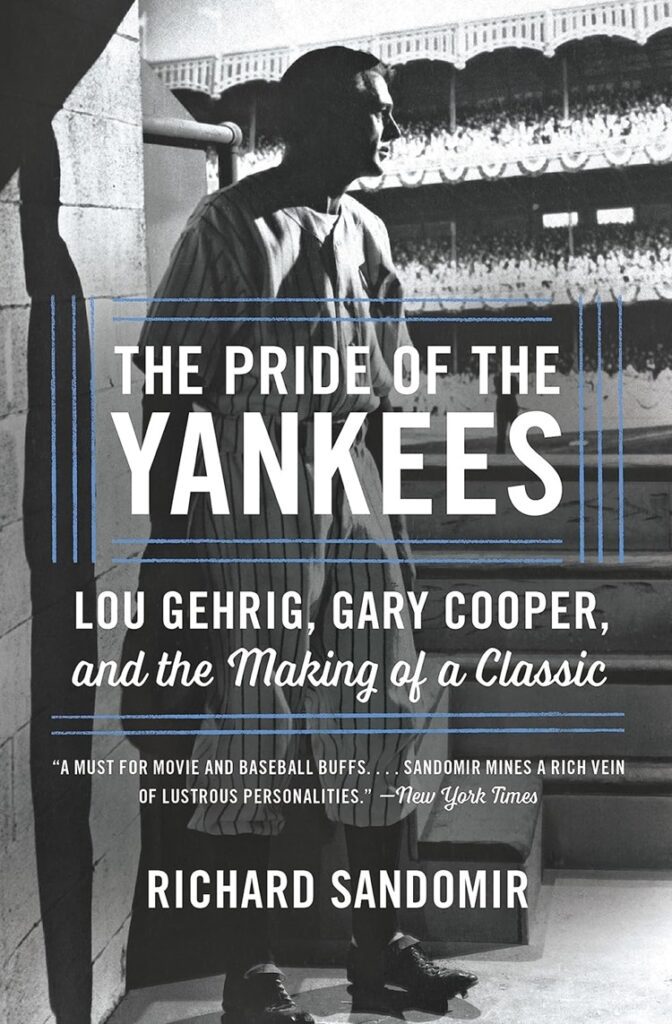
Field of Dreams, The Natural, and Bull Durham may be the first movies that come to mind when you think of baseball, but the first classic baseball film, The Pride of the Yankees, was made in 1942. The story of Yankees’ great Lou Gehrig, who played in 2,130 consecutive games until he developed – and later died of – amyotrophic lateral sclerosis (ALS), starred Gary Cooper, Teresa Wright, and Walter Brennan, and is considered the first blockbuster sports movie.
The climax of the movie is Cooper’s reenactment of Gehrig’s “Luckiest Man in the World” speech before his retirement, which is often referred to as the “Gettysburg Address of Baseball”. When people recall a film clip of Gehrig’s address at Yankee Stadium, they’re actually thinking of Cooper’s portrayal of Gehrig in Pride of the Yankees. There are only two short clips of the actual speech, which Gehrig gave on July 4, 1939 at Yankee Stadium. There was no official full-length recording of the speech, and newspaper accounts were inaccurate. Gary Cooper’s portrayal is the best representation of the baseball great’s farewell speech.
After watching a few newsreels of the Gehrig saga, producer Samuel Goldwyn agreed to make a movie about the fallen Yankee, and he offered Gehrig’s widow Eleanor a $30,000 fee for film rights to the story. Eleanor took a hands-on approach to approving the script, and she worked closely with sportswriter Paul Gallico, who wrote the original version of the screenplay. Eleanor lobbied for a warts-and-all portrait of Lou’s childhood and chaotic upbringing by an alcoholic father and domineering mother. (Until he met the vivacious Eleanor, Gehrig had a reputation as a mama’s boy.)
The final script portrayed a watered-down version of Gehrig’s mother, Christina, who in reality was much more strident than in the film version. According to the film, Eleanor and Christina eventually warmed to each other; but this was just poetic license. Other characters in the film were changed to be more audience-friendly. Eleanor’s father was a concessionaire for the Chicago Parks System who was fired after an adultery scandal, and his trajectory was also cleaned up for the movie.
The book also has plenty of background material on Cooper, particularly his ongoing struggles with producer Samuel Goldwyn regarding salary and contracts. Cooper knew his worth, but Goldwyn sometimes bickered with him regarding money, in true producer fashion.
An ex-major leaguer named Lefty ‘O Doul was hired to teach Cooper to successfully fake batting, throwing, and fielding. Cooper was raised in the wilds of Montana, but his athleticism didn’t extend to baseball. Although it took awhile, ‘O Doul succeeding in teaching Cooper how to fake hitting and fielding. However, turning him from a right-hander to a left-hander like Gehrig was a tricky proposition, and there is speculation that the film negatives were reversed to accomplish this.
Babe Ruth played himself in the movie (against the wishes of Gehrig’s widow), providing brash contrast to Cooper-as-Gehrig’s dignified air. The Babe lost weight for the role, and was on his best behavior during filming.
Lou Gehrig died in 1941, and Pride of the Yankees premiered at the Pantages Theatre in Hollywood in the summer of 1942, the last glittery Hollywood premiere until the end of World War II.
New York Times’ reporter Richard Sandomir drew from letters, memos, scripts, and other correspondence to provide a detailed chronicle of the movie, from conception to premiere to broadcast TV showings in the 1960s. His book tells you more than anyone could know about the movie, with lots of background about Gehrig, Ruth, and the rest of the cast, as well as the behind-the scenes wrangloing it took to get he movie made.
If you love movie or baseball history, this book will sate your curiosity and then some. The Pride of the Yankees: Lou Gehrig, Gary Cooper, and the Making of a Classic is a well-researched book that gives you the nuts and bolts of how one of the first major movie biopics was made.